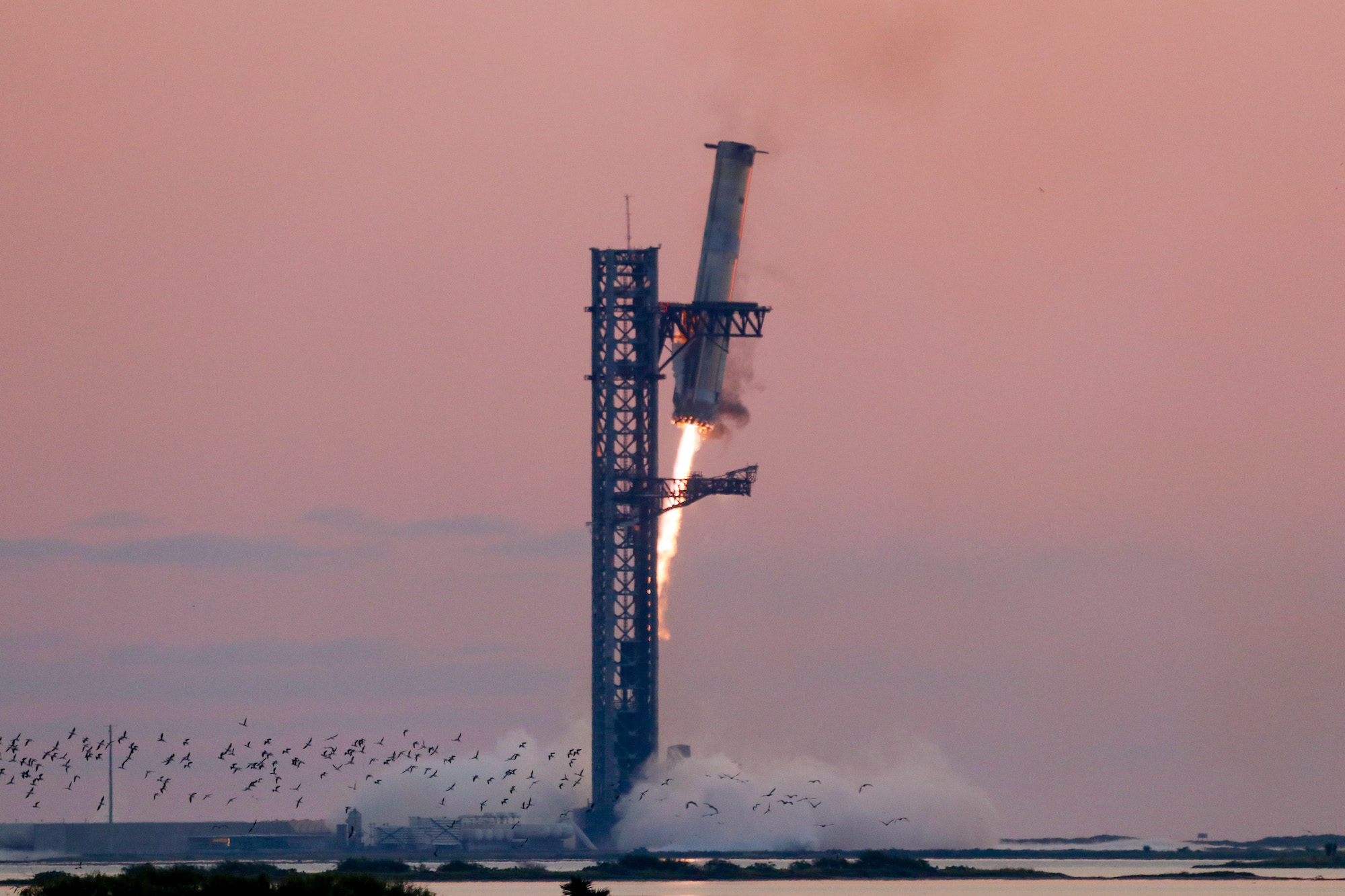- Vision Quest
- Posts
- This Week in Tech 42
This Week in Tech 42
Tesla and SpaceX are pushing the envelope on earth and in space
Welcome to the cutting edge ⚔️
Read time: 5 min
Today’s Slate
Everything that was announced at the Tesla We, Robot event
Adobe unveils AI video generator to rival OpenAI and Meta
Meta officially launches the Quest 3S - an affordable introduction to mixed reality
SpaceX continues to demonstrate what is possible - which is more than you think. They caught a damn rocket with robot arms.
The. future. is. here.
Tesla We, Robot Event
At a glance
Cybercab Unveiled: Tesla revealed the Cybercab, a driverless robotaxi with a futuristic design, lacking a steering wheel or pedals. It charges wirelessly and seats two.
Robovan Surprise: Tesla introduced the Robovan, a versatile vehicle for passenger transport or cargo, emphasizing flexibility.
Controlled Demos: The event included limited rides and featured Optimus robots that interacted with attendees, though much of their autonomy involved behind-the-scenes human assistance.
Production Timeline: Cybercab production is aimed for 2026-2027, with limited autonomous trips expected in Texas and California by next year.
Our vision
Tesla's Cybercab and Robovan signal a pivotal shift toward autonomous, electric transportation, but real-world deployment remains complex. The reveal highlights both Tesla's innovative strides and the regulatory and technical challenges still ahead in the autonomous vehicle race. If successful, the Cybercab could reshape urban transit and challenge incumbents like Waymo, but the heavy reliance on controlled settings hints at the long path to full autonomy.
Check out MKBHD’s review of the Robotaxi
At a glance
Tesla showcased its Optimus robots at the "We, Robot" event, highlighting their ability to interact, serve drinks, and engage with attendees.
Despite the impressive display, many interactions were backed by human assistance and remote operations, not fully autonomous AI.
Attendees and analysts, like Robert Scoble and Morgan Stanley’s Adam Jonas, noted human intervention, with some robots even acknowledging partial human control.
Our vision
While Tesla's event demonstrated the potential of humanoid robotics, the reliance on human assistance indicates that fully autonomous capabilities are still a work in progress. This definitely highlights the challenges in developing sophisticated, independent robotic systems and suggests that true autonomy in humanoid robots may be further away than the event's presentation implied.
The big takeaway we are aligned with is finding our way to an abundant and multi-planetary future. Something Tesla and SpaceX seem determined to deliver on (eventually).
Autonomy will create the world we want
It covers all transportation needs with fewer cars, since they won't sit idle for most of the day anymore
Instead, cities will be greener & liveable
— Tesla (@Tesla)
3:26 AM • Oct 11, 2024
Robotaxi & Robovan
— Tesla (@Tesla)
3:40 AM • Oct 11, 2024
The future is the closest it’s ever been - sci-fi has become reality

Artificial Intelligence
At a glance
Adobe introduces Firefly Video Model, an AI text-to-video generator aimed at media professionals.
Unlike other offerings from OpenAI, Meta, and Runway, Adobe claims its model is trained solely on licensed content, reducing ethical and copyright concerns.
The model is currently in beta, accessible through a waitlist, with a focus on creating seamless footage that blends with traditional video production.
Brands like Gatorade and Mattel already use Adobe’s AI tools for design and product packaging.
Our vision
Firefly Video Model marks Adobe’s strategic entry into AI-driven video generation, positioning itself as a trustworthy option for creative professionals who value content ownership and ethical AI practices. As video creation increasingly leverages generative AI, Adobe's emphasis on commercial safety could set a new industry standard and appeal to cautious content creators.
Spatial Computing
At a glance
Released on October 15, the Quest 3S is Meta's entry-level VR headset priced at $300 (128GB) and $400 (256GB). Bundles include three months of Meta+ and the new Batman: Arkham Shadow game.
Both the Quest 3S and Quest 3 use the same Snapdragon XR2 chipset and 8GB RAM. The 3S offers better battery life but has lower-resolution fresnel lenses (1832x1920) compared to Quest 3's pancake lenses (2064x2208) and lacks a depth sensor.
The Quest 3S provides an affordable option while the Quest 3 targets users seeking higher visual fidelity.
Our vision
The Meta Quest 3S aims to broaden access to VR with a balance of affordability and performance, positioning it as a competitor against entry-level devices. The decision to use lower-resolution lenses keeps costs down, making the headset suitable for newcomers to VR while retaining key features like gesture controls. This approach aligns with Meta's strategy of offering a tiered VR experience, appealing to both casual users and those seeking premium features, potentially capturing a larger share of the growing VR market.
At a glance
The Quest 3s launches at $300 (128GB) and $400 (256GB) with Snapdragon XR2 Gen 2 chipset. Includes passthrough but lacks a depth sensor and proximity sensor.
Quest 3S uses lower-resolution fresnel lenses, reducing clarity but has improved battery life (2.5 hours vs. 2.2). Quest 3 offers better visuals with pancake lenses and a wider field of view.
Quest 3S undercuts premium headsets like Apple Vision Pro and Vive Focus Vision with a focus on affordability and decent performance.
Our vision
Meta’s Quest 3S aims to democratize access to VR by offering a cost-effective headset with solid performance. It targets users seeking an entry-level VR experience without compromising on mixed reality features, while reserving premium visuals and precision for the higher-end Quest 3.
While Meta has a solid head start, we all know what Apple is capable of when they take their time and eventually become the market leader. Let the battle for reality enhancement rage on.
Space
At a glance
SpaceX successfully launched its fifth Starship test flight, catching the Super Heavy booster with mechanical arms (Mechazilla) after launch, marking a critical milestone for rapid rocket reuse.
Starship's upper stage completed a controlled reentry and splashdown in the Indian Ocean, with minor damage to heat shields.
SpaceX aims to advance towards orbital refueling, rapid reusability, and supporting NASA's Artemis lunar missions, aiming to increase launch cadence from multiple pads in Texas and Florida.
Our vision
SpaceX’s successful booster recovery and Starship test flight mark a pivotal step toward cost-effective space travel and interplanetary missions. With improved reusability, SpaceX is pushing the boundaries of launch frequency and capability, aiming to enable human exploration of the Moon and Mars.
This progress positions SpaceX as a leader in the next phase of space exploration, directly impacting NASA's plans and the broader future of space travel.
REMINDER: @SpaceX will demonstrate Starship Ship-to-Ship Propellant Transfer next year.
“It's hard to make this not look a little bit naughty because it's two ships connecting and doing a fluid transfer.” —Elon Musk
Starlink live footage of that will be 🔥 Bow chicka wow wow! x.com/i/web/status/1…
— ALEX (@ajtourville)
8:53 PM • Oct 15, 2024
How did you like this week's edition? |
Walaaxy, the world's #1 automated prospecting tool 🚀
Waalaxy is the world's #1 tool for automated LinkedIn prospecting, with over 150K users and a 4.8/5 rating from +1,200 reviews.
Why? Because it allows anyone, without any technical skills, to automate LinkedIn prospecting:
Reach out to 800 qualified prospects per month.
Capture your competitors' audience.
Test a market for your business.
And countless other use cases.
Turn LinkedIn into your #1 acquisition channel (and get a 10x ROI with the subscription).

/cdn.vox-cdn.com/uploads/chorus_asset/file/25670623/Robotaxi_75.jpg)
/cdn.vox-cdn.com/uploads/chorus_asset/file/25675214/Cowboy_Optimus.png)





